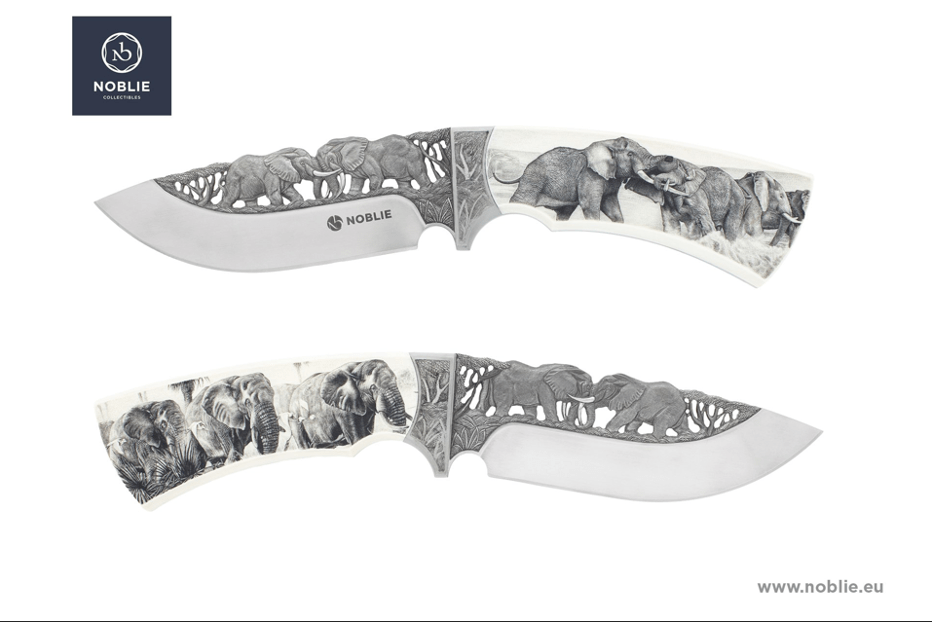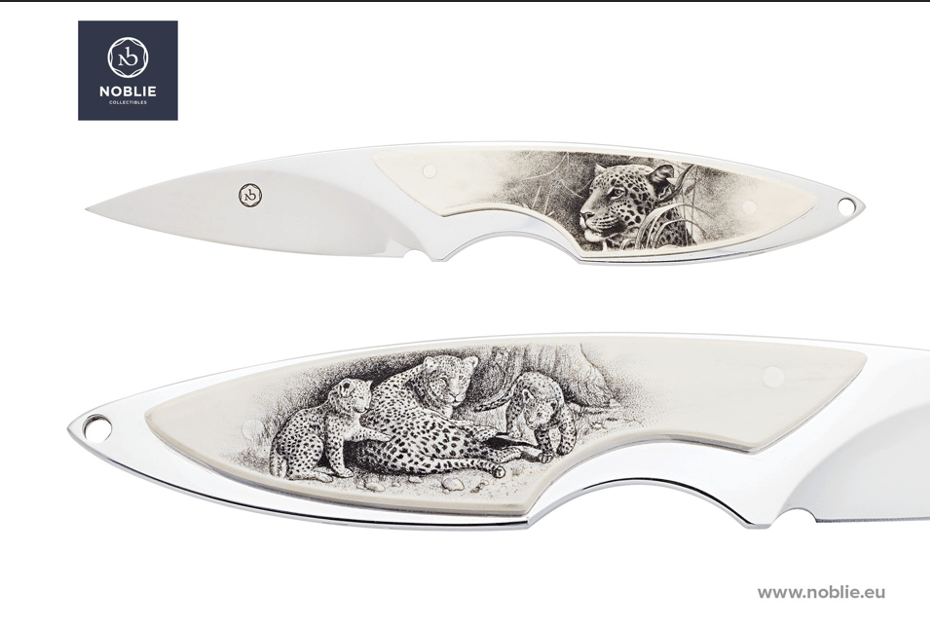Scrimshaw is the decoration of bone or mammoth tusk, such as whale’s teeth or walrus tusks, with fanciful designs. Most often, it is made from the bones and teeth of sperm whales, the baleen of other whales, and the tusks of walruses. These are complex engravings in the form of drawings and inscriptions on the surface of a bone or tooth, while the engraving is highlighted by pigment. Scrimshaw making probably began on whaling ships in the late 18th century and lasted until commercial whaling was banned. The practice has survived as a hobby and as a trade for commercial artisans. Scrimshaw technique is used to decorate custom knives.
Who is scrimshander?
A person who makes a scrimshaw is known as a scrimshander. Scrimshanders and collectors legally acquire whale teeth and marine tusks through real auctions, estate sales and antique dealers. Collectors and artists check provenance and only deal with well-known and reputable dealers to ensure that ivory is sold legally. Scrimshaw that has been illegally found can be confiscated by customs officers around the world, depreciate dramatically in value, and is very difficult to resell, as the limited channels through which collectible scrimshaw passes serve as a check on unscrupulous individuals. As with any other form of fine art, experienced museums, auction houses, or other experts can usually spot a fake.
Scrimshanders create hand carved scrimshaws that can be a 3D artifact. They carved useful tools like a jagging wheel. The jagging wheel is a tool used to pierce and trim the piecrust.
How is scrimshaw made?
An individual artist does collectable and museum quality scrimshaw from start to finish. Their individual technique can be recognized throughout the piece.
The material in the area where it will be scrimmed must first be polished to a fine polish. Polishing seals the surface and prevents later added pigments from staining the material in unwanted areas. Some artists then draw patterns by hand on the surface, while others first draw on thin paper and then transfer their design to the surface.
However they start, the next step is to score the surface of the material with fine scratches or thousands of small holes (called stippling) using sharp tools such as a steel scribe, hobby knives, or sewing needles held in a vise. Many scrimshanders choose to make their own tools for this task. Some scrimshanders have taken to using a modern mechanical device, similar to a modified tattoo artist’s tool, rather than working by hand. Such a tool can greatly reduce the time it takes to make a piece, but many scrimshanders and collectors prefer the look and originality of a collectible handcrafted piece.
The next step is to apply the pigment, which is then removed from the surface, leaving behind the color in the scratches or holes. This is a unique way in which a scrimshaw is a line or dot shaded and subsequent “inking”, which brings the image to life on the surface of the material.
Custom scrimshaw knives as a modern art form
Although scrimshaw is rarely done on whalebone these days, some artists still practice it. Common modern materials are ivory (fossil, mammoth tusk, walrus), warthog tusk, hippo tusk, giraffe bone, mother-of-pearl, buffalo horn and camel bone. The modern scrimshaw usually retains the nautical themes of historical scrimshaw but can also go far beyond the traditional.
To date, trade and carving techniques have led to more advanced, but not as unique, scrimshaw carving.
Noblie Knife Shop is using this technique to decorate their custom knives to revive and preserve the ancient art of scrimshaw. Collectible scrimshaw knives are handcrafted, and each knife takes from one to several months to make. On the presented works, you can appreciate the highest level of scrimshader’s skills. The scrimshaw knives of the Noblie workshop are truly collectible class, they are in the best private collections of knives in the world
What materials other than ivory do scrimshanders work with?
Scrimshanders work with different materials other than ivory that do not pose a threat to living beings. To create unique collectibles such as pen bases, letter openers, key rings, fireplace sets, cribbage boards, chandeliers and lamps, and more, scrimshanders use naturally shed antlers from deer, elk, and moose. Antler is stronger than ivory and is used to make knife scales, handles and other parts that wear out quickly. They also use tagua nuts, vegetable ivory to make small unique decorations, small pieces of the playing field, etc. The horn scrimshaw is most commonly seen on black powder hunting horns.
Noblie workshop uses a legal material for the manufacture of their custom knives – mammoth tusk. This is an ancient fossil material; this is the tusk of ancient elephants – mammoths. Since these animals are long extinct, their mammoth tusks are now found in the Arctic zone. Mammoth tusk is a noble and expensive material that does not harm living animals.
Mammoth Tusk Care and Preservation
Clear paste wax or high quality automotive wax seals the surface after oiling. Bone products are even more brittle (more fibrous and porous) and should be treated the same way: with a light, clear mineral oil. Organic oils are not recommended, as they will eventually accelerate discoloration, as in old piano keys exposed to natural oils in the hands.
Professional art and historical artefact restorers generally advise against applying any type of coating (such as Renaissance wax) to organic objects such as mammoth tusk. A sensible choice in terms of storage and display and what best preserves whalebone: keep out of direct sunlight, handle with cotton gloves or freshly washed hands, and avoid storage in areas with fluctuating humidity and temperature. Coating organic objects can lead to possible cracking.
How to care for scrimshaw or mammoth tusk sculptures?
A scrimshaw, when handled with care, is a valuable piece of art or jewelry, a family heirloom that will be passed on for future generations to enjoy. Scrimshaw should be treated just like jewelry, but it also has some special care requirements.
The applied image is permanent, but wear and some substances can remove the pigment or damage or stain the polished surface, and in some cases even remove fine lines.
Ivory should not be wetted unless necessary. The pigments, especially colors, may fade or be removed completely; and the ivory may swell and/or crack when exposed to high levels of humidity. If your ivory gets wet, it is recommended that to dry it thoroughly as soon as possible.
Direct, bright sunlight can dry out the ivory excessively over time and cause “checks” (cracks) to appear. Sun can also bleach some color inks and other pigments. Soap, shampoo, detergents, highly chlorinated water and especially jewelry cleaning solutions tarnish the surface of ivory, as well as remove pigments and can even corrode some fine scrimmed lines. Some jewelry cleaning solutions not only remove the pigments, but also leave a terrible stain on the surface of ivory that cannot be safely removed.
Most dirt and oils may be removed by simply dusting or wiping gently with a clean, soft cotton cloth. Stubborn dirt can be removed with a cotton swab dipped in rubbing alcohol and gently wipe the surface. Need to remember, DO NOT SCRUB! A rough brushing can remove pigment from fine lines or even damage fine lines so that they no longer hold ink.
Although not always considered necessary for properly dried ivory, you can apply a thin layer of Renaissance Wax or warm beeswax to the ivory once or twice a year to keep it looking its best. Also possible to use a quality paste wax if it does not contain additives. Ivory should be waxed whenever it is cleaned, as any alcohol used in cleaning will remove it. Many owners enjoy the high-gloss and sheen of waxed and polished mammoth tusk.
Broken, friable, or very dirty items that require repair, reinforcement, or extensive cleaning should be taken to a professional conservator. Unfortunately, there have been cases where “repairs” attempted by well-meaning but inexperienced persons. In some cases, a failed repair or deep cleaning can lead to a disaster that even a professional cannot fix.




